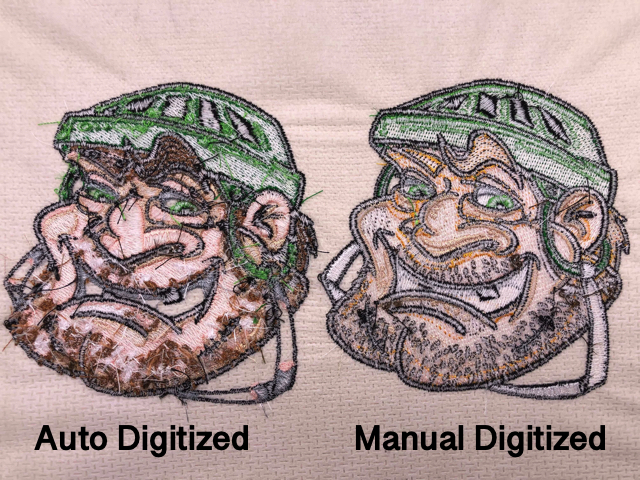Premier Digitizing for Embroidery: Perfect Stitch Every Time
Explore Various Sorts Of Embroidery Digitizing Techniques
Embroidery digitizing has developed dramatically over the years, offering a myriad of techniques to bring styles to life in the digital world. The realm extends to extra sophisticated techniques like photorealistic embroidery digitizing and the remarkable world of 3D embroidery digitizing.
Standard Hand Needlework Digitizing
Typical hand embroidery digitizing entails the process of transforming detailed hand-stitched styles right into electronic layouts for machine needlework. This technique requires experienced artisans to thoroughly assess the handmade design and then make use of specialized software program to recreate it in a digital format. Each stitch, shade, and information needs to be meticulously converted to make sure that the significance of the initial hand embroidery is preserved in the electronic version.
Among the crucial difficulties of traditional hand embroidery digitizing is catching the ins and outs and nuances of the handmade design. Digitizing for Embroidery. Craftsmens should have a deep understanding of different needlework techniques, such as satin stitch, chain stitch, and French knots, to precisely reproduce these methods in the electronic world. In addition, they need to have a keen eye for information to ensure that the electronic layout keeps the exact same level of virtuosity and workmanship as the initial hand-stitched item
Punching Method
To perfectly shift from traditional hand embroidery digitizing to the boxing method, craftsmens must currently concentrate on transforming the detailed digital styles into directions that needlework makers can analyze. The boxing method includes using specialized software to develop electronic data which contain commands for the embroidery maker to follow. This procedure calls for a deep understanding of not just the style itself yet additionally the capacities and restrictions of the needlework equipment.

Auto-Digitizing Software Application Programs
Needlework digitizing has been reinvented by the introduction of auto-digitizing software application, providing artisans with innovative devices to transform digital styles into needlework machine instructions efficiently. Auto-digitizing software application use algorithms to analyze electronic photos or vector data and produce needlework styles automatically. These programs enable quick and exact conversion of detailed designs into stitch patterns, saving effort and time for embroiderers.
Among the key advantages of auto-digitizing software program is its easy to use user interface, making it obtainable to both beginners and knowledgeable digitizers. These programs usually include attributes such as stitch modifying devices, thread color matching, and the ability to preview the last stitched layout. Furthermore, auto-digitizing software program can handle intricate layouts with numerous shades and intricate details, producing premium needlework files ideal for different garments and textile tasks.
While auto-digitizing click here for more info software application provides convenience and efficiency, it is crucial for individuals to comprehend the constraints of automated digitizing. Fine-tuning and manual changes might still be called for to achieve the preferred embroidery quality, specifically when taking care of elaborate or distinct styles. By leveraging the capacities of auto-digitizing software program alongside hands-on digitizing methods, craftsmens can boost their needlework digitizing procedure and produce stunning embroidered items.
Photorealistic Embroidery Digitizing
Utilizing sophisticated electronic imaging strategies, accomplishing photorealistic outcomes in needlework digitizing has come to be a popular skill among modern-day craftsmens. This technique includes converting high-resolution photos into intricate stitch patterns that carefully simulate the initial style, leading to needlework pieces that show lifelike detail and depth.
To attain photorealistic embroidery digitizing, artisans must have an eager eye for information and a thorough understanding of just how different stitch kinds and densities can influence the last result. By thoroughly drawing up each color and shade in the photo, embroiderers can produce a digital file that overviews the needlework maker to replicate the nuances of the original image properly.
Photorealistic embroidery digitizing is specifically preferred in developing custom-made layouts for garments, home decor, and art pieces where capturing the significance of a photograph or artwork is critical. This strategy permits craftsmens to change memories, landscapes, portraits, and elaborate art work into sensational stitched work of arts that showcase get more a blend of traditional workmanship and advanced modern technology.
3D Needlework Digitizing
With the advancement of electronic imaging techniques in achieving photorealistic lead to needlework digitizing, the exploration of 'D Needlework Digitizing' offers a new measurement to the details of design duplication. 'D Embroidery Digitizing' describes the three-dimensional digitizing method that adds depth and texture to needlework designs, producing an extra practical and aesthetically enticing last item. This technique makes use of software application that replicates the effect of light and shadow on the needlework style, improving its total visual effect.
Among the key advantages of 'D Embroidery Digitizing' is its capacity to make layouts look more lifelike and dynamic. By adding depth to the needlework style, the final item appears more realistic and fascinating (Digitizing for Embroidery). Furthermore, this technique permits more imaginative liberty in style implementation, enabling embroiderers to experiment with different appearances and impacts that were formerly testing to achieve
Verdict
